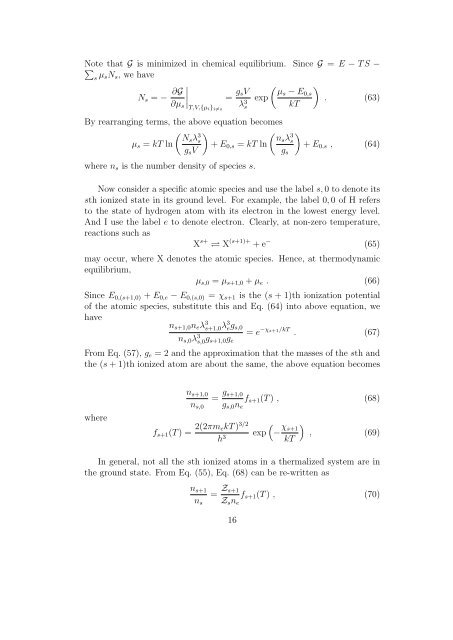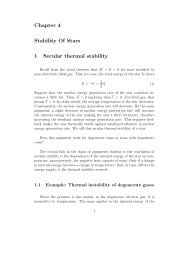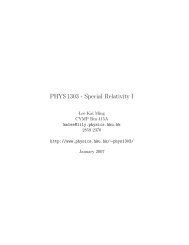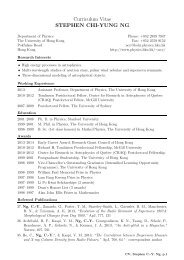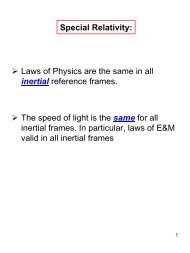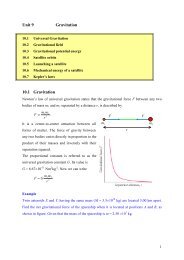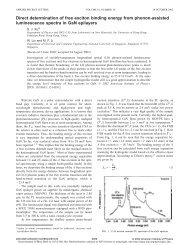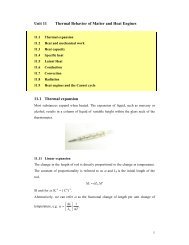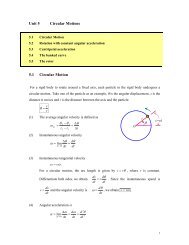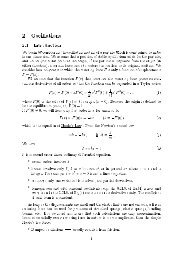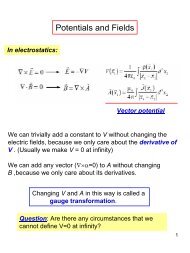Chapter 2 Stellar Structure Equations 1 Mass conservation equation
Chapter 2 Stellar Structure Equations 1 Mass conservation equation
Chapter 2 Stellar Structure Equations 1 Mass conservation equation
Create successful ePaper yourself
Turn your PDF publications into a flip-book with our unique Google optimized e-Paper software.
Note<br />
∑<br />
that G is minimized in chemical equilibrium. Since G = E − T S −<br />
s µ sN s , we have<br />
N s = − ∂G<br />
∂µ s<br />
∣<br />
∣∣∣T,V,{µi<br />
} i≠s<br />
= g sV<br />
λ 3 s<br />
( )<br />
µs − E 0,s<br />
exp<br />
. (63)<br />
kT<br />
By rearranging terms, the above <strong>equation</strong> becomes<br />
( )<br />
( )<br />
Ns λ 3 s<br />
ns λ 3 s<br />
µ s = kT ln + E 0,s = kT ln + E 0,s , (64)<br />
g s V<br />
g s<br />
where n s is the number density of species s.<br />
Now consider a specific atomic species and use the label s, 0 to denote its<br />
sth ionized state in its ground level. For example, the label 0, 0 of H refers<br />
to the state of hydrogen atom with its electron in the lowest energy level.<br />
And I use the label e to denote electron. Clearly, at non-zero temperature,<br />
reactions such as<br />
X s+ ⇋ X (s+1)+ + e − (65)<br />
may occur, where X denotes the atomic species. Hence, at thermodynamic<br />
equilibrium,<br />
µ s,0 = µ s+1,0 + µ e . (66)<br />
Since E 0,(s+1,0) + E 0,e − E 0,(s,0) = χ s+1 is the (s + 1)th ionization potential<br />
of the atomic species, substitute this and Eq. (64) into above <strong>equation</strong>, we<br />
have<br />
n s+1,0 n e λ 3 s+1,0λ 3 eg s,0<br />
n s,0 λ 3 s,0g s+1,0 g e<br />
= e −χ s+1/kT . (67)<br />
From Eq. (57), g e = 2 and the approximation that the masses of the sth and<br />
the (s + 1)th ionized atom are about the same, the above <strong>equation</strong> becomes<br />
where<br />
n s+1,0<br />
n s,0<br />
f s+1 (T ) = 2(2πm ekT ) 3/2<br />
h 3<br />
= g s+1,0<br />
g s,0 n e<br />
f s+1 (T ) , (68)<br />
(<br />
exp − χ )<br />
s+1<br />
, (69)<br />
kT<br />
In general, not all the sth ionized atoms in a thermalized system are in<br />
the ground state. From Eq. (55), Eq. (68) can be re-written as<br />
n s+1<br />
n s<br />
= Z s+1<br />
Z s n e<br />
f s+1 (T ) , (70)<br />
16


